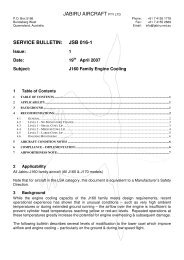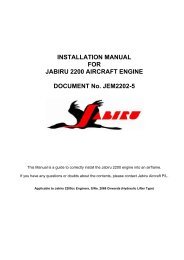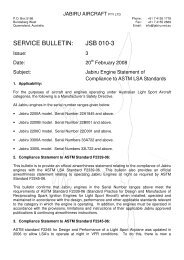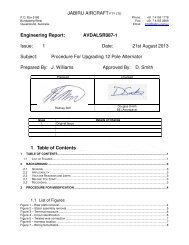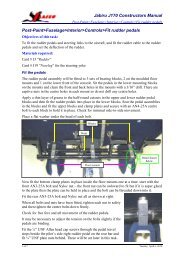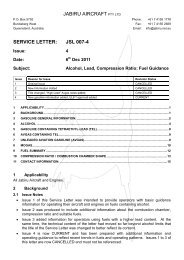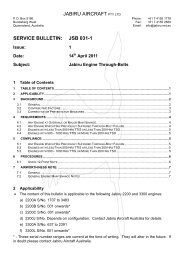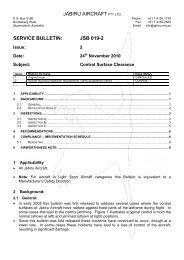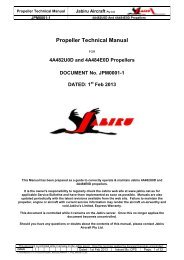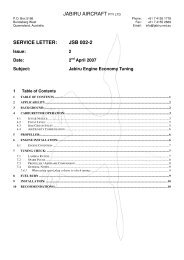INSTRUCTION AND MAINTENANCE MANUAL FOR JABIRU 2200 ...
INSTRUCTION AND MAINTENANCE MANUAL FOR JABIRU 2200 ...
INSTRUCTION AND MAINTENANCE MANUAL FOR JABIRU 2200 ...
You also want an ePaper? Increase the reach of your titles
YUMPU automatically turns print PDFs into web optimized ePapers that Google loves.
Jabiru Aircraft Pty LtdInstruction & Maintenance ManualJabiru <strong>2200</strong> Aircraft EngineHydraulic Valve Lifter Models13.2 Normal Operation NotesThe following are tips to ensure a long life. They are intended to bring attention toimportant aspects of caring for a Jabiru <strong>2200</strong> engine. For details on the required work,refer to the main body of this manual.13.2.1 Regular ChecksWith ignition and master OFF and throttle closed turn the prop by hand and observeengine for odd noises or heavy movements.Turn the engine over by hand before starting to check for regular compressions. Ifirregular (one cylinder with lower compression than others) a leak-down or similarpressure differential test should be done. If the results show a low-compressioncylinder, contact Jabiru Aircraft or our authorized local representative.Compression Test: Condition of compression can be gauged by testing the enginewith a compression gauge. The test is carried out with the engine warm, wide openthrottle, ignitions OFF. Turn over on starter. A reading below 90 PSI may indicateremoval of head and possibly cylinder.Pressure Differential Test: As an alternative to a compression test, a pressuredifferential test (Leak down) can be carried out. This is a much better test of thecondition of rings, bore, head sealing and valve. This is the normal test used in aviationand requires specific equipment.The test is carried out with the engine in warm to hot condition. Pressure input of 80PSI; a second gauge reads the differential. This is done with piston on TDC on thefiring stroke. Note that the propeller needs to be restrained. A differential of lower than80/60 indicates a problem.Problems can be better identified using the leak down:v) Blow by through the crankcase vent indicates worn rings or borevi) Leaking from carby indicates a poor intake valve sealvii) Leaking from exhaust indicates a poor exhaust valve sealviii) Head leak indicates poor head to cylinder sealWith the problem narrowed down, correction work can more easily be carried out.Your Tension Wrench should be accurate. It should be a “good” brand and have hadsome method of calibration. Even new wrenches can be un-calibrated and can vary tomanufacturers claims.The Coil Gap can be adjusted easily by cutting a 15mm wide strip of plastic or thincard (thickness .010”). Place between magnets on flywheel and coil. Check both sides,that is each coil to each magnet (4 checks).This document is controlled while it remains on the Jabiru server. Once this no longer applies the document becomes uncontrolled.REVISION 0 1 2 3 4 5 6 7 8 9 Dated : June 2010 Issued By: DPS Page: 105 of 116L:\files\Manuals_For_Products\Engine_Manuals\Transition\JEM2204-9_I&M_unsigned.docx





